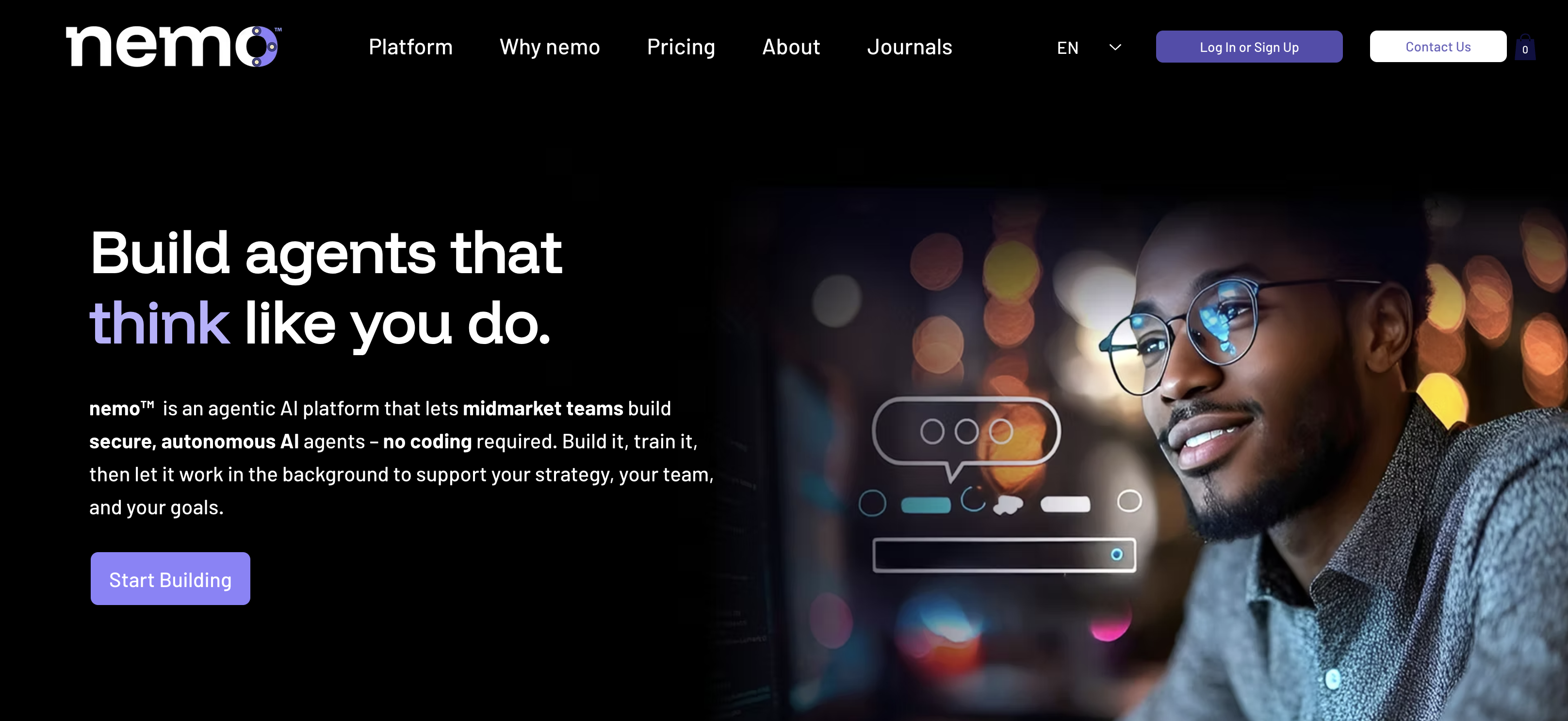
Digital Strategy Firm Turns AI Service Offering into a Product
How Navigamo Used Lamatic’s Headless AI Platform to Launch nemo™
Overview
“We needed to productize — but every platform we tried backed us into a corner.”
— Blas Giffuni, Co-Founder, Navigamo
Navigamo is a digital strategy consultancy that helps businesses leverage technology to better serve their customers. In late 2023, they began developing high-touch, AI-powered user experiences for clients. The results were promising, but the delivery model wasn’t scalable.
After dozens of custom implementations, Navigamo’s Co-Founder, Blas Giffuni, had seen the pattern: every project started from scratch, and off-the-shelf chatbot builders were riddled with limitations. The team was spending too much time hacking around rigid tools that couldn’t evolve with client needs.
So when Blas discovered Lamatic, a platform purpose-built to speed up AI delivery, he wondered: Could we use Lamatic to turn our growing AI service offering into a scalable - and far more profitable - product?
The answer, it turned out, was “Not really.”

The Twist:
When the Platform Wasn’t the Product
It turned out that Lamatic’s visual builder wasn’t well-suited for Navigamo’s clients, who were non-technical teams in regulated industries. So Blas made an unexpected proposal:
“We asked: What if we could build our own interface on top of Lamatic’s infrastructure?”
— Blas Giffuni
Lamatic’s response? “No.”
Instead, Lamatic offered Navigamo access to a developer-friendly software development kit (SDK) and a pragmatic API — direct access to Lamatic’s secure, multi-tenant, SOC 2 & GDPR-compliant AI backbone. They also introduced Navigamo to a dev agency they knew could use this SDK to transform Blas’ vision into a scalable B2B SaaS product.
The result was nemoTM — a multi-tenant SaaS application that allows non-developers to deploy secure, custom smart agents inside their own websites, portals, and direct-to-consumer communication platforms.
The Challenge
Navigamo had proven demand. Customers wanted AI assistants embedded into their daily workflows. But they didn’t want generic tools. They needed:
- Custom behavior for different workflows and industries
- Secure deployment inside private environments
- A way to iterate quickly on prompts, models, and logic
- Multi-tenant management, billing, and controls
- A product that felt like theirs, not someone else’s logo
Off-the-shelf tools couldn’t deliver. They locked teams into rigid UX patterns, black-box logic, and slow iteration cycles.
“We were always compromising on what we could build, how we could deploy it, or how fast we could respond to client needs.”
— Blas Giffuni
The bigger problem was that scaling services without turning them into products meant spinning up the same infrastructure and rebuilding the same agent patterns over and over again.
Navigamo needed to turn its services into software to serve clients profitably at scale.
The Solution

With Lamatic’s headless AI SDK and API, Navigamo could build a fully custom front-end — nemo — while offloading all the infrastructure, security, and orchestration to Lamatic.
This meant:
- No DevOps headaches — model routing, usage limits, chat memory, agent switching, embedding, search, retrieval, billing, and user/session management were all handled out of the box
- Enterprise-grade compliance from day one
- Massive speed gains in launching, managing, and evolving AI-powered products
“We have full control over the product experience, and Lamatic gives us the tools to move like a startup while building like an enterprise.”
— Blas Giffuni
nemo wasn’t just another front-end — it became a product platform. Blas and team now had the tooling to support dozens (eventually hundreds) of smart agent deployments across multiple clients, use cases, and industries.
The Impact
nemo’s MVP launched just over 3 months from project start to public beta.
- Operational break-even: 4 customers
- Project payback: 12 months
- Time saved per client deployment: 36 hours
- Agent updates & feature iterations that used to take weeks now take hours
Perhaps more importantly, nemo’s architecture now allows:
- Rapid onboarding of new clients
- Secure agent hosting inside each client’s own environment
- Real-time iteration on smart agent logic, retrieval, and front-end experience
- Full ownership of the brand, pricing, and UX
- nemo users have complete control to enhance and optimize their agents
What surprised me wasn’t just how fast we could build nemo. It’s how fast we can now evolve it — feature by feature, client by client. Lamatic made that possible.
Let's turn your expertise into AI Agents together
Book a demo to see how Lamatic can turn your pain point or idea into a Reliable Agentic Application.
Get a Demo
